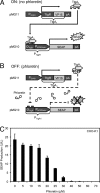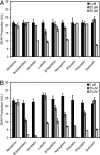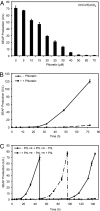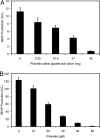Controlling transgene expression in subcutaneous implants using a skin lotion containing the apple metabolite phloretin
- PMID: 19549857
- PMCID: PMC2700147
- DOI: 10.1073/pnas.0901501106
Controlling transgene expression in subcutaneous implants using a skin lotion containing the apple metabolite phloretin
Abstract
Adjustable control of therapeutic transgenes in engineered cell implants after transdermal and topical delivery of nontoxic trigger molecules would increase convenience, patient compliance, and elimination of hepatic first-pass effect in future therapies. Pseudomonas putida DOT-T1E has evolved the flavonoid-triggered TtgR operon, which controls expression of a multisubstrate-specific efflux pump (TtgABC) to resist plant-derived defense metabolites in its rhizosphere habitat. Taking advantage of the TtgR operon, we have engineered a hybrid P. putida-mammalian genetic unit responsive to phloretin. This flavonoid is contained in apples, and, as such, or as dietary supplement, regularly consumed by humans. The engineered mammalian phloretin-adjustable control element (PEACE) enabled adjustable and reversible transgene expression in different mammalian cell lines and primary cells. Due to the short half-life of phloretin in culture, PEACE could also be used to program expression of difficult-to-produce protein therapeutics during standard bioreactor operation. When formulated in skin lotions and applied to the skin of mice harboring transgenic cell implants, phloretin was able to fine-tune target genes and adjust heterologous protein levels in the bloodstream of treated mice. PEACE-controlled target gene expression could foster advances in biopharmaceutical manufacturing as well as gene- and cell-based therapies.
Conflict of interest statement
The authors declare no conflict of interest.
Figures





References
-
- Baumgartel K, et al. Control of the establishment of aversive memory by calcineurin and Zif268. Nat Neurosci. 2008;11:572–578. - PubMed
-
- Sharpless NE, Depinho RA. The mighty mouse: Genetically engineered mouse models in cancer drug development. Nat Rev Drug Discov. 2006;5:741–754. - PubMed
-
- Weber W, Fussenegger M. Inducible product gene expression technology tailored to bioprocess engineering. Curr Opin Biotechnol. 2007;18:399–410. - PubMed
-
- Ulmer JB, Valley U, Rappuoli R. Vaccine manufacturing: Challenges and solutions. Nat Biotechnol. 2006;24:1377–1383. - PubMed
Publication types
MeSH terms
Substances
LinkOut - more resources
Full Text Sources
Other Literature Sources

